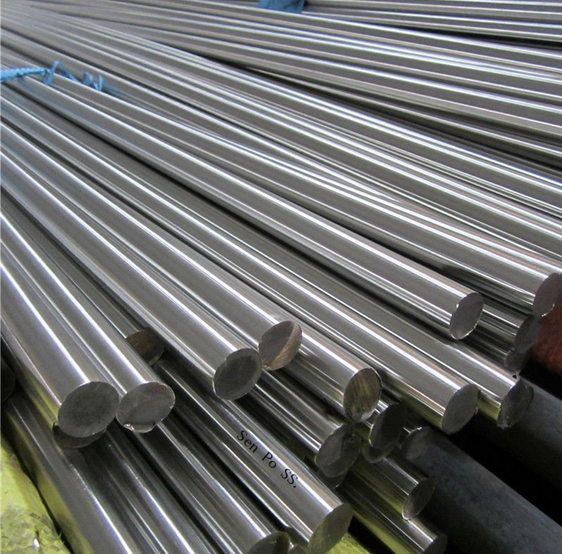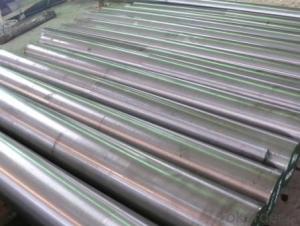AISI 304 Stainless Steel Bar /stainless steel shafting bright surface
- Loading Port:
- Tianjin
- Payment Terms:
- TT OR LC
- Min Order Qty:
- 100 kg
- Supply Capability:
- 1000 kg/month
OKorder Service Pledge
Quality Product, Order Online Tracking, Timely Delivery
OKorder Financial Service
Credit Rating, Credit Services, Credit Purchasing
You Might Also Like



- Q:Are stainless steel pipes suitable for underground irrigation systems?
- Yes, stainless steel pipes are suitable for underground irrigation systems. Stainless steel is highly resistant to corrosion, making it an excellent choice for installations that are exposed to moisture, soil, and other elements found underground. It provides durability and longevity, ensuring that the irrigation system remains functional and reliable for an extended period. Additionally, stainless steel pipes have high tensile strength, making them capable of withstanding the pressure and stress that can occur in underground installations. Overall, stainless steel pipes are a reliable and suitable option for underground irrigation systems.
- Q:What are the specifications of stainless steel decorative pipes?
- The steel pipe seamless steel pipe and welded steel pipe (seamed pipe) two categories. It can be divided into round tube and special-shaped tube according to the sectional shape. The round steel tube is widely used, but there are some special-shaped steel tubes such as square, rectangle, semicircle, hexagon, equilateral triangle and octagon.
- Q:How do you prevent clogging in stainless steel pipes?
- To prevent clogging in stainless steel pipes, regular maintenance is essential. This includes flushing the pipes with hot water regularly to remove any potential buildup. Additionally, avoiding the disposal of grease, oil, or large solid particles down the drain is crucial. Installing screens or traps at the drains can also help to catch any debris before it enters the pipes.
- Q:Can stainless steel pipes be welded?
- Yes, stainless steel pipes can be welded. Stainless steel is a popular material used in various industries due to its high corrosion resistance and strength. Welding is one of the common methods used to join stainless steel pipes together. However, it is important to use the appropriate welding techniques and equipment to ensure a successful weld. Stainless steel has different grades, each with its own specific welding requirements. The welding process for stainless steel pipes typically involves using a filler material that matches the grade of stainless steel being welded. It is also crucial to properly clean and prepare the surfaces to be welded to ensure a strong and durable joint.
- Q:Can stainless steel pipes be used for natural gas?
- Yes, stainless steel pipes can be used for natural gas. Stainless steel is highly resistant to corrosion and can withstand the high pressures and temperatures associated with natural gas transmission and distribution. Additionally, stainless steel pipes have excellent fire resistance properties, making them a safe choice for natural gas applications.
- Q:What are the different types of stainless steel pipe flanges?
- There are several different types of stainless steel pipe flanges available, each designed for specific applications and requirements. Some common types include: 1. Weld Neck Flanges: These flanges have a long tapered hub and are welded to the pipe, providing excellent strength and durability. They are ideal for high-pressure and high-temperature applications. 2. Slip-On Flanges: These flanges slide over the pipe and are then welded in place. They are easy to install and provide a secure connection. Slip-on flanges are commonly used in low-pressure and non-critical applications. 3. Socket Weld Flanges: These flanges have a socket-like end that fits over the pipe and is then welded in place. They are used for smaller-sized pipes and are known for their resistance to leakage. 4. Threaded Flanges: These flanges have internal threads that allow them to be screwed onto the pipe. They are used in low-pressure applications and are easy to install and remove. 5. Lap Joint Flanges: These flanges consist of two components – a stub end and a loose backing flange. They are used in systems requiring frequent dismantling or where alignment is crucial. 6. Blind Flanges: These flanges are solid and have no bore, making them ideal for closing off the end of a pipe. They are commonly used in piping systems that require periodic inspection or cleaning. 7. Orifice Flanges: These flanges have concentric or eccentric holes to measure the flow rate of a fluid. They are often used in flow measurement applications. 8. Spectacle Blind Flanges: These flanges consist of a combination of a blind flange and a spacer. They are used to separate sections of a pipe system and can be easily removed for maintenance or repair. It is important to select the appropriate type of stainless steel pipe flange based on the specific requirements of the application, such as pressure, temperature, and fluid compatibility.
- Q:304 stainless steel pipe, 20*2 pressure, how many kilograms?
- 304 stainless steel is a brand of stainless steel produced according to the ASTM standard in the United states. 304 is equivalent to 0Cr19Ni9 in our country(0Cr18Ni9) stainless steel. 304 chromium 19%, containing nickel 9%. The 304 is the most widely used stainless steel, heat-resistant steel, steel, steel industry utility. For food production equipment, general chemical equipment, nuclear energy, etc..
- Q:How do stainless steel pipes compare to fiberglass pipes?
- Distinct characteristics and advantages set stainless steel pipes and fiberglass pipes apart. When comparing the two, one must consider factors such as strength, durability, corrosion resistance, cost, and ease of installation. In terms of strength, stainless steel pipes have a clear advantage, known for their exceptional strength and durability. They can withstand high-pressure applications and heavy loads. On the other hand, fiberglass pipes are relatively weaker and may not be suitable for high-strength and resistance applications. Durability is another crucial aspect. Stainless steel pipes are highly durable, enduring extreme temperatures, chemicals, and physical stress without deteriorating. Fiberglass pipes, though durable, are more susceptible to damage from impact, extreme temperatures, and UV radiation. Therefore, stainless steel pipes are a more reliable choice for long-term use in harsh environments. Corrosion resistance is significant when selecting pipes. Stainless steel pipes are renowned for their excellent corrosion resistance, making them ideal for applications where exposure to corrosive substances is a concern. Fiberglass pipes, while relatively resistant to many chemicals, can be affected by certain corrosive substances and may require additional protective coatings. Cost is an important consideration for any project. Due to the higher cost of raw materials and manufacturing processes, stainless steel pipes tend to be more expensive than fiberglass pipes. Conversely, fiberglass pipes are generally more affordable, making them a cost-effective option for budget-constrained projects. Finally, ease of installation is worth mentioning. The weight and rigidity of stainless steel pipes require specialized tools and expertise for installation. In contrast, fiberglass pipes being lightweight and flexible, are easier to handle and install, reducing labor costs and time. In conclusion, stainless steel pipes offer superior strength, durability, and corrosion resistance compared to fiberglass pipes. However, fiberglass pipes are a more cost-effective option and easier to install. Ultimately, the choice between the two depends on the specific project requirements, considering factors such as application, budget, and environmental conditions.
- Q:How are stainless steel pipes joined or connected?
- Stainless steel pipes can be joined or connected using various methods such as welding, threading, flanging, and compression fittings.
- Q:What are the common applications for stainless steel pipes?
- The unique properties and versatility of stainless steel pipes make them suitable for a wide range of applications. Some common uses include: 1. Plumbing and water supply systems: Stainless steel pipes are commonly employed in plumbing and water supply systems because of their resistance to corrosion and ability to withstand high pressure. They provide a reliable and long-lasting solution for transporting water and other fluids. 2. Oil and gas industry: Stainless steel pipes are extensively utilized in the oil and gas industry for the transportation of oil, gas, and other hydrocarbons. Their ability to withstand high temperatures and pressures makes them suitable for exploration, production, and transportation of these resources. 3. Food and beverage industry: The hygienic properties and corrosion resistance of stainless steel pipes make them widely used in the food and beverage industry. They are commonly employed for transporting liquids, such as milk, juices, and processed foods, ensuring the safety and quality of the products. 4. Chemical and pharmaceutical industry: Stainless steel pipes, being highly resistant to corrosion, are ideal for the chemical and pharmaceutical industry. They are used for transporting various chemicals, acids, and solvents, ensuring the integrity of the substances being transported. 5. Construction and architecture: Stainless steel pipes are utilized in construction and architectural applications due to their aesthetic appeal and structural strength. They are often used for handrails, balustrades, structural columns, and decorative purposes, adding a modern and sleek look to buildings. 6. Automotive industry: Stainless steel pipes are used in the automotive industry for exhaust systems because of their heat resistance and durability. They can withstand high temperatures and corrosive gases, ensuring the efficient operation of the exhaust system. 7. Power generation: Stainless steel pipes find application in power plants for the transportation of steam, water, and other fluids. They are resistant to high temperatures and pressures, making them suitable for power generation purposes. 8. Aerospace industry: Stainless steel pipes are employed in the aerospace industry for various applications, including aircraft exhaust systems, hydraulic systems, and fuel lines. They offer a high strength-to-weight ratio, corrosion resistance, and reliability, meeting the stringent requirements of the aerospace industry. In conclusion, stainless steel pipes are utilized in various industries due to their corrosion resistance, durability, and versatility. They find applications in plumbing, oil and gas, food and beverage, chemical and pharmaceutical, construction, automotive, power generation, and aerospace industries, among others.
1. Manufacturer Overview |
|
|---|---|
| Location | |
| Year Established | |
| Annual Output Value | |
| Main Markets | |
| Company Certifications | |
2. Manufacturer Certificates |
|
|---|---|
| a) Certification Name | |
| Range | |
| Reference | |
| Validity Period | |
3. Manufacturer Capability |
|
|---|---|
| a)Trade Capacity | |
| Nearest Port | |
| Export Percentage | |
| No.of Employees in Trade Department | |
| Language Spoken: | |
| b)Factory Information | |
| Factory Size: | |
| No. of Production Lines | |
| Contract Manufacturing | |
| Product Price Range | |
Send your message to us
AISI 304 Stainless Steel Bar /stainless steel shafting bright surface
- Loading Port:
- Tianjin
- Payment Terms:
- TT OR LC
- Min Order Qty:
- 100 kg
- Supply Capability:
- 1000 kg/month
OKorder Service Pledge
Quality Product, Order Online Tracking, Timely Delivery
OKorder Financial Service
Credit Rating, Credit Services, Credit Purchasing
Similar products
New products
Hot products
Related keywords

























